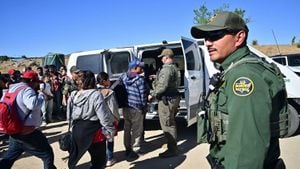Migration patterns continue to be a contentious issue along the U.S.-Mexico border, particularly as significant events shape the horizon. Ahead of Donald Trump's controversial inauguration, the urgency for hopeful immigrants became palpable, demonstrated by the emergence of large migrant caravans. Just as the clock ticked toward the 20th of January, around 1,500 migrants embarked on their arduous trek toward the United States from Southern Mexico, driven by fears surrounding impending border restrictions.
Reports from the early hours of January 19, 2024, reveal these migrants setting off with the aim of reaching their destination before the inauguration. Their motivation? A collective anxiety about the future, fueled by campaigns proposing tighter immigration regulations and possible deportations. Many individuals characterized this moment as their final opportunity, likely envisioning barriers and fortified borders once Trump's presidency formally commenced.
The thematic backdrop of this latest caravan echoes similar waves of migration seen over the years, evoking memories of past caravans laden with the hopes of those seeking asylum or the American Dream. The political climate surrounding immigration has been tumultuous, characterized by fluctuated immigration policies shifting based on changing administrations. This latest surge of migrants has underscored the desperation felt by many as they hope to secure refuge and opportunity.
Notably, this migration wave was not isolated—it formed part of a more extensive chain of movements stemming from environments rife with violence, poverty, and social instability. Families, bolstered by the prospects of safety and stability, joined the ranks of hopeful migrants. These individuals often represent communities grappling with economic hardship, where seeking refuge across borders emerges as their primary recourse. Addressing the root causes of such migration remains pivotal, as humanitarian crises continue to prompt significant demographic shifts.
Migration experts suggest the recent surge may reflect broader trends indicating increased migration pressure from Central America and beyond. The convergence of these challenges has created what many describe as inevitable scenarios where large numbers of individuals are left with few options but to seek greener pastures elsewhere. Understanding and addressing these underlying factors is key to fostering long-term solutions.
Not surprisingly, as the political atmosphere at the U.S.-Mexico border becomes charged, reactions from corresponding authorities grow more stringent. Reports indicate U.S. Customs and Border Protection officials have braced for the possibility of increased crossings. With historical data predicting high volumes of encounters and apprehensions during such transitional periods, authorities find themselves at once preparing for the influx and grappling with managing the humanitarian aspects associated with it.
Transnational support networks also play pivotal roles—many migrants receive assistance from family, friends, and organized aid groups along their journeys. These networks help provide necessities, lodging, and advice for those undertaking perilous journeys through harsh terrains. For some, the act of migration is not solely for personal gain but forms part of broader familial responsibilities to pave pathways for future generations.
The psychological toll of undertaking these journeys also warrants mention. Reports articulate how separation from loved ones and unrelenting conditions during travel create emotional burdens many carry long after setting foot on new soil. Consequently, the communities migrants emerge from often bear the weight of collective trauma, fortifying their resolve but also leading to sacrifices.
Beyond the human narratives lies the geopolitical chessboard, heavily influenced by policies from the U.S. administration. Dialogue remains fraught with tension, often revolving around national security, immigration reform, and humanitarian obligations. Experts are urging lasting approaches rooted not purely within the boundaries of political tactics but with sincere commitments to tackling poverty, violence, and inequality across migrant-sending countries.
Cross-border stakeholders have underscored the need for comprehensive reform addressing not only migration flows but also the conditions fostering these movements. Calls for humane treatment of migrants intersect with the demand for reforms highlighting international cooperation addressing regional disparities—pointing toward longer discussions on investment, development initiatives, and collaborative border management.
Many individuals are keeping their fingers crossed as they attempt to revisit narratives of hope against relentless odds. For those on the ground, these narratives encapsulate resilience: families join together to defy adversity and pursue dreams afforded by the symbolic promise of the United States. Yet, what remains clear is there is no easy answer, and as trends forecast migration will only continue, both governments and communities face heightened responsibilities to advocate for the dignity of all individuals seeking refuge.
With hopes hanging on the horizon, the actions of governments, advocates, and the migrant population itself will be integral as the U.S. approaches this new chapter. The next few months may define how this pivotal issue will evolve—offering endless moments of reflection and questioning about what it truly means to seek shelter and safety.



